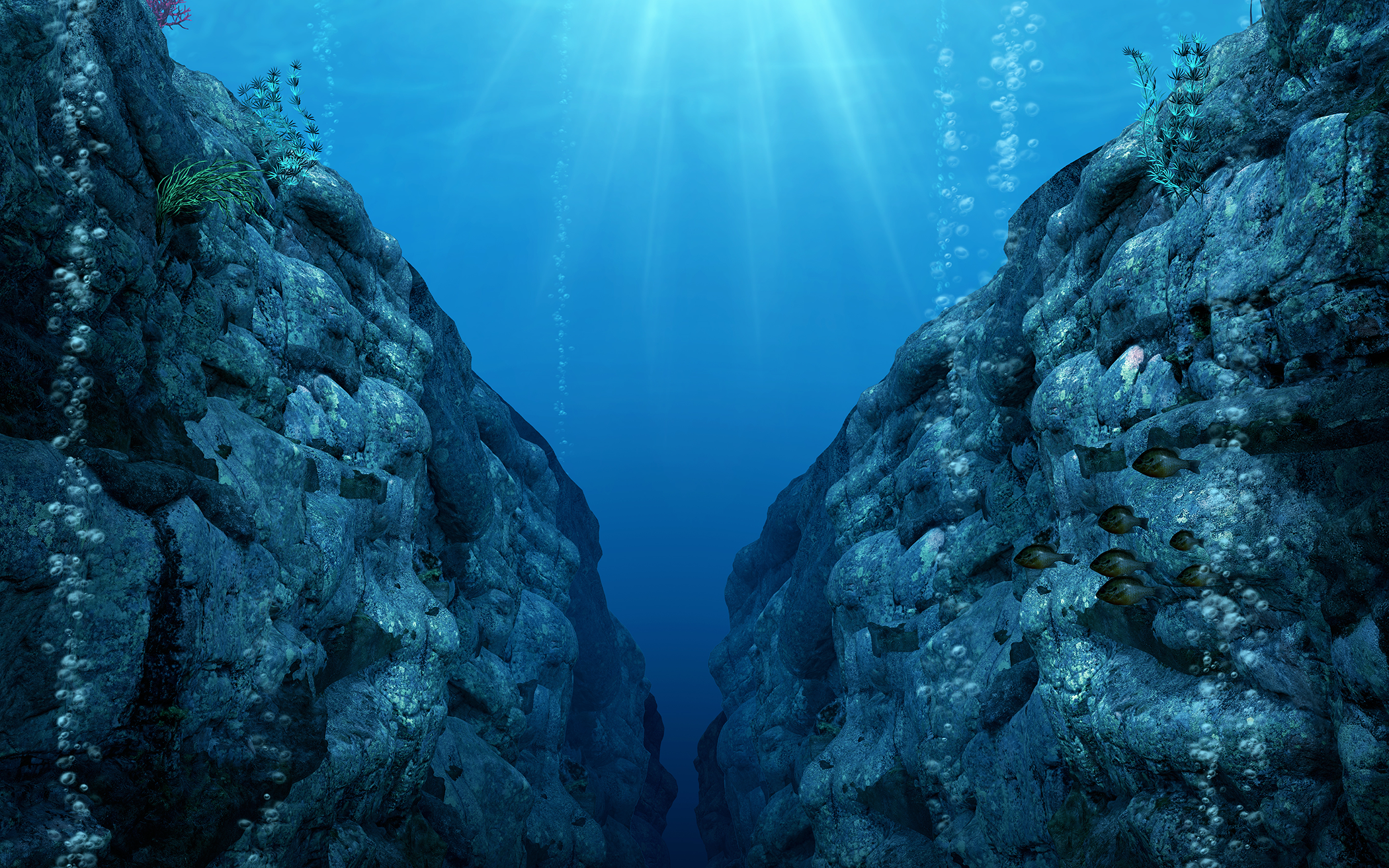Now faith is confidence in what we hope for and assurance about what we do not see. —Hebrews 11:1
With an unquenchable thirst for adventure, Jacques Piccard and Don Walsh huddled together inside a reinforced-steel submersible and slowly descended into a dark trench seven miles below the ocean surface.
Nine years before Apollo 11 rocketed human beings into space to circle the moon and then walk its alien surface, an ambitious plan was made to boldly explore an alien landscape much closer to home. In the winter of 1960, the submarine Trieste was lowered into the choppy waters of the North Pacific Ocean, 250 miles off the island of Guam. Its mission was to reach the bottom of the Mariana Trench, the deepest known oceanic crevice in the world.
Dipping to a staggering 35,814 feet below the ocean surface, the Mariana Trench is so deep that if Mount Everest were flipped upside down and placed inside, the peak of the mountain would not touch the bottom. The trench is continually etched as the rocky edge of the Pacific tectonic plate slides into and then underneath the Mariana plate. Begun 180 million years ago, this slow-motion collision has formed a crescent-shaped crevice five times the length of the Grand Canyon. With 21 active volcanoes, this hellish underwater landscape is littered with hypothermal vents that discharge into the water like smokestacks. Boiling molten sulfur breaks through the crust, turning the water acidic and jet-black with chemical bacteria.
At the southern tip of the MarianaTrench is a slot-shaped indentation called Challenger Deep, the deepest known place on Earth. Here, intense pressure measures over 1,000 times that of the standard atmospheric pressure (the weight of 15 jumbo jets), enough to make land-dwelling creatures quickly collapse in on themselves.
As the reinforced submarine descended through the watery depths, Swiss scientist Jacques Piccard and U.S. Navy Lt. Don Walsh looked out a small window as sun-streaked ocean gave way to pitch black. They descended through the twilight and midnight zones, through the abyss, and into the trench. At 30,000 feet, an exterior viewing window cracked and shook the submarine. They kept going. After a harrowing 4 hours and 47 minutes, they touched down and became the first humans ever to reach the deepest place on the planet: Challenger Deep.
On a Friday 2,000 years ago, Christ was crucified. He was taken down from the cross, wrapped in cloth, and placed in a tomb. A large stone was rolled over the entrance, sealing the tomb. There were no infrared sensors. No rock penetrating radar. No livestream. The details of what happened next are shrouded in mystery.
The Apostles’ Creed says Jesus “descended to hell.”
Many of the creed’s succinct summaries of the foundational truths about God have caused even the most devout to pause before professing “I believe.” But out of all the lines in the creed, scholars and thoughtful Christians for centuries have wondered specifically what the four words “he descended into hell” could mean. With holy curiosity, we turn to the Bible to find answers.
1 Peter 3:18-20 is a key passage that is often cited as supporting evidence of the creed’s unapologetic statement. In these verses, Peter says that Christ, after being raised from the dead, went to preach to the disobedient imprisoned spirits from the time of Noah. On the surface, this passage might seem straightforward, yet scholars passionately debate what it means and caution us about constructing a theology based on a few perplexing lines. Strangely, apart from this one passage, the Bible is largely silent on what the creed so specifically asserts.
Still searching for insight, many have turned to the interpretive wisdom of the Heidelberg Catechism. Rather than offering details, the catechism paints with a broader brush by drawing on Scripture passages that point to the implications of Christ’s work. Q&A 44 says that Christ descended to hell “to assure me during attacks of deepest dread and temptation that Christ my Lord, by suffering unspeakable anguish, pain, and terror of soul, on the cross but also earlier, has delivered me from hellish anguish and torment” (Isa. 53; Matt. 26:36-46; 27:45-46l Luke 22:44; Heb. 5:7-10).
According to the catechism, in times of temptation, difficulty, and doubt, the four powerful words “he descended to hell” assure us that no matter what we might experience in this life, God is with us and for us.
The catechism implies that sometime between Friday and Sunday, Christ sank through the stone floor of that sealed tomb. Following the creed’s suggestion of hell as somewhere down below, hidden from human eyes, he descended through layers of watery depths, into the midnight zone, the abyss, and still deeper into the unfathomable trenches of hell. The creed’s “he descended to hell” succinctly summarizes what the lyricist of Psalm 139 says poetically: “Where can I go from your Spirit? Where can I flee from your presence? If I go up to the heavens, you are there; if I make my bed in the depths, you are there. … Even there your hand will guide me, your right hand will hold me fast” (Ps. 139:7-8, 10).
Scripture, the Apostles’ Creed, and the Heidelberg Catechism all speak with one voice: Christ went all the way down into the deepest darkness to find us, hold our hands, and lead us out of despair into the light of his marvelous new life.
On March 26, 2012, filmmaker James Cameron squeezed into a vertical submersible and was lowered into the thrashing waves of the North Pacific Ocean. His goal was to repeat what had been accomplished 62 years earlier by Piccard and Walsh—to touch down in Challenger Deep, the deepest place on Earth on the far end of the Mariana Trench. After a harrowing descent at twice the speed of the Trieste, Cameron reached a depth of 35,787 feet in 2 hours and 37 minutes. Although the submarine suffered some minor mechanical failures, after about three hours under the crushing pressure at the bottom of the ocean, he ascended into the daylight and became only the third person to reach the mysterious and dangerous trench floor.
Since then, others have descended to the depths, but only Christ went all the way down to the absolute bottom of reality.
The good news of the gospel, affirmed in the Apostle’s Creed and applied in the Heidelberg Catechism, makes it clear that Christ went all the way down so that we can rest knowing that no dark place is beyond his reach. Now, not even hell on earth is devoid of Christ’s presence. Our personal trials and tribulations can make us feel lost in a murky prison of pain and loneliness. We might feel crushed by the weight of guilt. For some of us, depression sits heavy on our shoulders, bearing down with increasing pressure. For all of us at one time or another, the light fades from our eyes as sadness envelops us. But we are not alone. God knows. God sees. God is present.
On Friday, Christ died. On Saturday, Christ descended to hell. On Sunday, Christ rose from the depths of crushing death. Forty days later, Christ ascended to heaven and sat down at God’s right hand to assure us that his presence, love, and power reach all the way from the highest high to the lowest low. That is very good news.
Discussion Questions
- How have you understood the phrase that Jesus “descended into hell,” in the Apostles’ Creed?
- Have you experienced God’s presence in the midst of your darkest moments? Can you describe it?
- How can we help each other through our difficult, even painful, times, especially when there seems to be no relief? How can we best strengthen each other’s faith through these times?
About the Author
Sam Gutierrez is the Associate Director at the Eugene Peterson Center for the Christian Imagination at Western Theological Seminary. More of his creative work can be found at printandpoem.com









